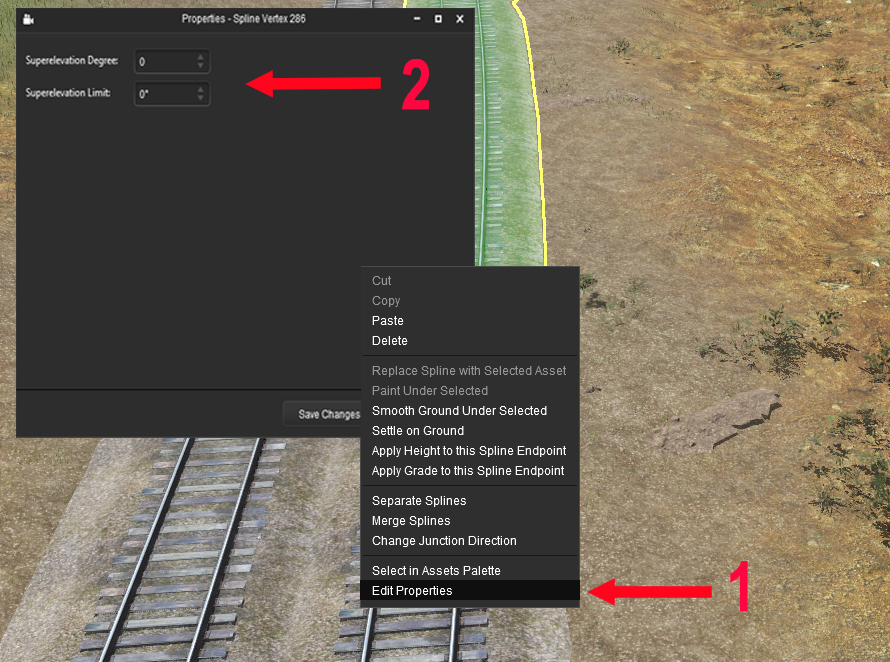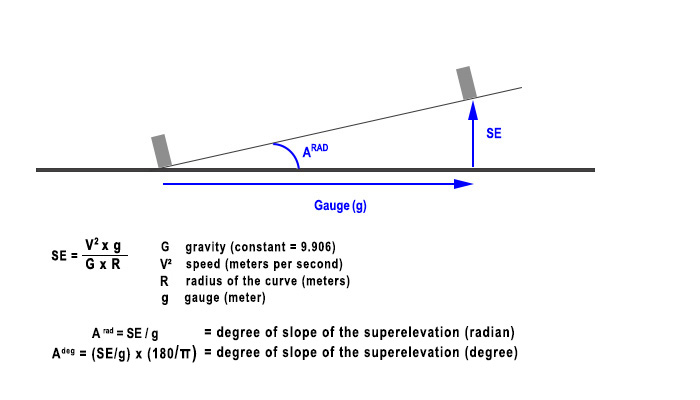HowTo/Superelevation Trainz22
(→What is superelevation in Trainz 22?) |
(→Surperelevation : theoritical base) |
||
| Line 72: | Line 72: | ||
</table> | </table> | ||
<br><br> | <br><br> | ||
| + | |||
| + | == '''Superelevation: how do we go about it?''' == | ||
| + | <br> | ||
| + | To proceed to the calculations, download and save to your hard drive the spreadsheet [https://1drv.ms/x/s!ApXRYIL4PqiQgfwdDV8UOxK0tkPtAQ?e=nNyVKj Here] | ||
| + | |||
| + | |||
| + | Proceed in two steps : | ||
| + | * measure the chord and arrow of your curve | ||
| + | * proceed to the calculations with the spreadsheet<br><br> | ||
| + | <u>Measure the chord and arrow of your curve :</u><br> | ||
| + | <table> | ||
| + | <tr> | ||
| + | <td width=100><td width='800'>In your Asset Pallet, select the spline 'ruler' <kuid:447125:108> Ruler Metric or <kuid:447125:109> Ruler Imperial | ||
| + | Measure the lengths of the chord and the arrow as shown opposite | ||
| + | </td> <td>[[File:img399.jpg]]</td> | ||
| + | </tr> | ||
| + | </table> | ||
| + | <br><br> | ||
| + | <u>Procced to the calculations whith the spreadsheet :</u><br><br><br> | ||
| + | <table> | ||
| + | <tr> | ||
| + | <td width=100><td width='820'> | ||
| + | *Enter the values of chord and arrow (1)<br> | ||
| + | *Indicate the maximum speed in the bend and choose between 'standard' or 'metric' gauge (2)<br> | ||
| + | *Look at the value of SuperElevation now displayed (3) : it doesn't have to exceed 16 cms (6.3 inches) in standard gauge tracks and 10 cms (3.94 inches) in metrics -French standard-. If these values are exceeded, reduce the Max speed.<br> | ||
| + | *Note the value of superelevation degree (4) and complete the property <b>'Superelevation Degree'</b> of your track as shown in the first section. | ||
| + | *Also complete the second property <b>'Superelevation Limit'</b> with these values : 6,4 (standard gauge) or 5,8 (metric gauge). | ||
| + | </td> <td>[[File:img401bis.jpg]]</td> | ||
| + | </tr> | ||
| + | </table><br><br> | ||
| + | <br> | ||
Revision as of 05:18, 4 October 2024
What is superelevation in Trainz 22?
The "superelevation" or the slope of rails in curves is proposed since T:ANE. This page updates the instructions for Trainz 22
To resist centrifugal force and and not to wear out prematurely the outer rail, the track must be tilted on bends.
Applying a gradient to a curved section of track is called superelevation.
Here is the example of a machine launched to 80 kph in a curve of 500 meters of beam. The slope of the track has been set to 4 °.

To implement Superelevation in Trainz 22, follow the steps below :
| On the tools palette,select the highlighted icone as shown on the opposite picture (1)
Clic on the track to select it (2) Clic on one of the submits of the selected track (3) | 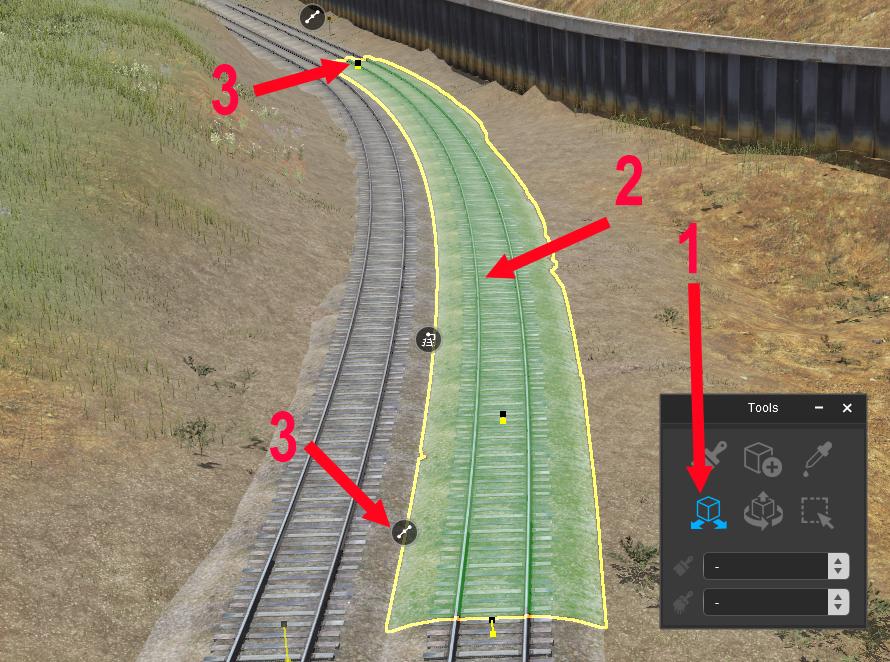 |
Surperelevation : theoritical base
Everything that follows in this section is designed to give you the theoretical basis for calculating a superelevation.
In the next section, a spreadsheet will be provided to do all the calculations for you.
- The Superelevation (SE) is the height that the outside rail takes compared with the internal rail in a curve.
It is calculated as the diagram below shows it:
- Of the four variables above (G, V, R,g), one is unknown at start: the radius of the curve.
The diagram below shows how to determine it :

- Trainz 22 introduces an aditionnal concept for determining the superelevation of a curve: the degree of curvature.
| Here, with a quarter-circle curve, the curve angle is 90°.
The more open the curve, the greater the angle. The tighter the curve, the smaller the angle. | 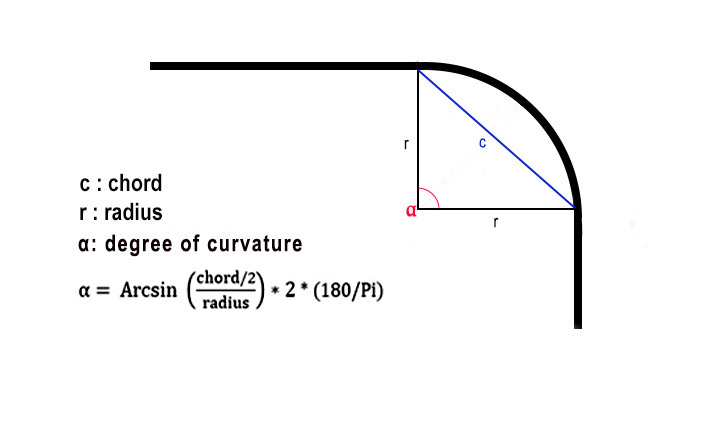 |
To apply superelevation in Trainz, we saw above that we had to calculate the 'superelevation degree'. More precisely, this means to determine the angle of the slope by degree of the concerned curvature. |
Superelevation: how do we go about it?
To proceed to the calculations, download and save to your hard drive the spreadsheet Here
Proceed in two steps :
- measure the chord and arrow of your curve
- proceed to the calculations with the spreadsheet
Measure the chord and arrow of your curve :
| In your Asset Pallet, select the spline 'ruler' <kuid:447125:108> Ruler Metric or <kuid:447125:109> Ruler Imperial
Measure the lengths of the chord and the arrow as shown opposite | 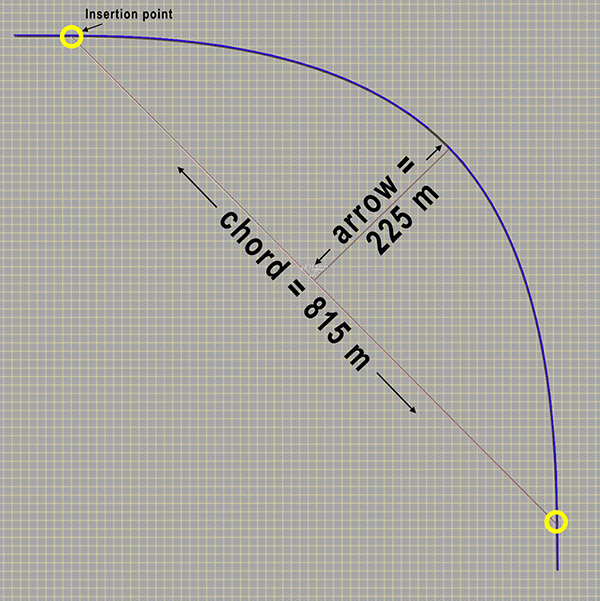 |
Procced to the calculations whith the spreadsheet :
